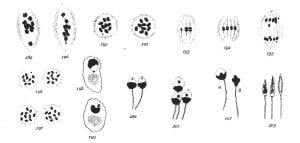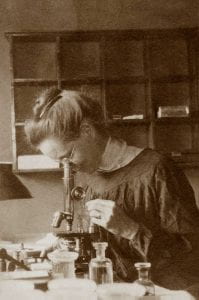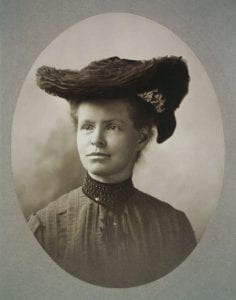To celebrate Women’s History Month we turn to a little known pioneer in cytology, Nettie Maria Stevens, one of the first scientists to discover that sex is determined by a particular configuration of chromosomes.
Born in Vermont in 1861, she excelled in school with her sights set on studying science. Although she got a late start entering college, she graduated from Stanford University in 1899 with her B.A. and in 1900 with her M.A. in biology. She moved on to Bryn Mawr College to pursue her Ph.D. in cytology and graduated in 1903. Receiving this high level of education was unusual for this time, especially for women, and her courage and perseverance echoes stories of women scientists of this generation.
 It was during her time at Bryn Mawr that she discovered sex chromosomes.
It was during her time at Bryn Mawr that she discovered sex chromosomes.  The pair of sex chromosomes that she studied later became known as the X and Y. While contemporary researchers used her work as a basis for their new studies, her contribution was overlooked and she was not given credit for her discoveries until later. Despite being ignored by the scientific community, she received acknowledgement from Bryn Mawr and was offered her ‘dream’ position in 1905. Unfortunately she was unable to accept this offer due to ill health. Nettie Stevens died at an early age from breast cancer in 1912.
The pair of sex chromosomes that she studied later became known as the X and Y. While contemporary researchers used her work as a basis for their new studies, her contribution was overlooked and she was not given credit for her discoveries until later. Despite being ignored by the scientific community, she received acknowledgement from Bryn Mawr and was offered her ‘dream’ position in 1905. Unfortunately she was unable to accept this offer due to ill health. Nettie Stevens died at an early age from breast cancer in 1912.
In an obituary in Science (11 Oct 1912), Thomas Hunt Morgan wrote:
“Her [Nettie Stevens] single-mindedness and devotion, combined with keen powers of observation; her thoughtfulness and patience, united to a well-balanced judgment, account, in part, for her remarkable accomplishment.”
Dr. Stevens’ work continues to be discovered and celebrated. In 1994 she was inducted into the National Women’s Hall of Fame. On May 5, 2017, Westfield State University honored Stevens through the naming ceremony of the Dr. Nettie Maria Stevens Science and Innovation Center. The center is where the university’s STEM-related degrees are all based.
Fun fact. In 2016, Google created a doodle of Nettie Stevens.



